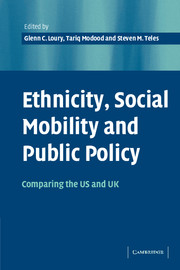Book contents
- Frontmatter
- Contents
- List of figures
- List of tables
- List of contributors
- Acknowledgements
- Introduction
- Part I Historical overviews
- Part II Informal social networks
- Part III Formal structures
- 9 Educational progress for African-Americans and Latinos in the United States from the 1950s to the 1990s: the interaction of ancestry and class
- 10 The educational attainments of ethnic minorities in Britain
- 11 Why America's black–white school achievement gap persists
- 12 Networks and niches: the continuing significance of ethnic connections
- 13 Nonwhite origins, Anglo destinations: immigrants in the USA and Britain
- 14 Social mobility of ethnic minorities
- 15 Ethnic minorities, employment, self-employment, and social mobility in postwar Britain
- Part IV Political institutions and processes
- Part V Normative analysis
- Author index
- Subject index
- References
15 - Ethnic minorities, employment, self-employment, and social mobility in postwar Britain
Published online by Cambridge University Press: 22 September 2009
- Frontmatter
- Contents
- List of figures
- List of tables
- List of contributors
- Acknowledgements
- Introduction
- Part I Historical overviews
- Part II Informal social networks
- Part III Formal structures
- 9 Educational progress for African-Americans and Latinos in the United States from the 1950s to the 1990s: the interaction of ancestry and class
- 10 The educational attainments of ethnic minorities in Britain
- 11 Why America's black–white school achievement gap persists
- 12 Networks and niches: the continuing significance of ethnic connections
- 13 Nonwhite origins, Anglo destinations: immigrants in the USA and Britain
- 14 Social mobility of ethnic minorities
- 15 Ethnic minorities, employment, self-employment, and social mobility in postwar Britain
- Part IV Political institutions and processes
- Part V Normative analysis
- Author index
- Subject index
- References
Summary
Introduction
This chapter discusses the economic experience and social mobility of postwar black and Asian migrants to the UK, and their British-born descendants. While attempts will be made to generalize about this, three points need to be made explicit at the outset: these relate to historical setting, scale, and geography. Firstly, although the migrations under consideration are relatively recent, they need to be set within their historical contexts, for only by fully appreciating the historical precursors and settings can we understand the motivations and trajectories of these migrants, the mechanisms that brought them to these shores, and the responses to their arrival here. Secondly, although aggregate statistical data will be used to generalize about patterns of minority mobility, it is vital to remember that the migrations and migrants under discussion are far from homogeneous. The Caribbean migrations and migrants differ markedly from those from the Indian subcontinent, and neither is internally uniform. The South Asian population in the UK is made up of myriad different national, regional, religious, and linguistic groups, each with its own reasons for being in Britain, its own identity, and its own potentialities (Robinson 1984, 1986) and there are also internal differences within the West Indian population (Peach 1984). Our account will therefore generalize at one level but will also attempt to demonstrate the significance of these distinctive identities for social mobility trajectories.
- Type
- Chapter
- Information
- Ethnicity, Social Mobility, and Public PolicyComparing the USA and UK, pp. 414 - 448Publisher: Cambridge University PressPrint publication year: 2005
References
- 5
- Cited by

